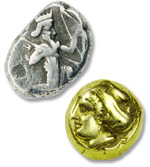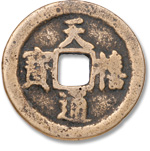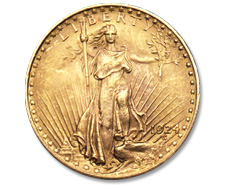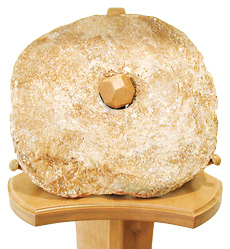What’s In a Coin?
Ancient Metals
The oldest known coins may have been minted by the kingdom of Lydia in Asia Minor, which began issuing coins around 700 B.C. composed of alluvial gold and silver that washed out of ore-rich mountains. The natural blends of the two metals as they tumbled down mountain streams was light yellow in appearance and is called electrum. When King Croesus took the throne in Lydia in 561 B.C., he realized the great variance of gold and silver content in electrum coinage, so he began separating the two metals and producing coins of either gold or silver with appropriate valuation. This method was soon adopted by other societies in the region.

Lydia Silver Drachm, 480-460 B.C.;
Electrum 1/8 Stater from Phokaia, 480‑400 B.C.
The first coins could also have been produced in the Greek island of Aegina. This major center of maritime trade minted coins from about 700-500 B.C. using silver imported from North Africa. The drawback of pure silver or gold coins was softness, causing any design, image or stamp to wear away quickly with handling. Over time, minters found that alloying these precious metals with copper or other base metals produced more suitable coinage.

Chinese Cash coin
Copper, which has been mined in Cyprus (which means copper) for over 5,000 years, has long been used in various forms of money or coinage. Chinese "cash" coins, dating from the 2nd century B.C., were round copper discs with a square or circular hole in the center (for stringing a quantity of the coins together). Copper is also soft in its pure form, but alloyed with tin, copper becomes hard and durable bronze. Small bronze axes known as "celts" were used as money in ancient Gaul and Britain, and the earliest Roman coins were lumps of metal known as "aes rude" (rough bronze).
Gradually, metal came to be equated with money in many civilizations and kingdoms. The very terms gold, silver, bronze, and copper would often indicate money in general or specific coinage issues. Many ancient coins are known today as "coppers" or "bronzes" – and the French word "argent" means money as well as silver.
United States Coins
The first coins issued by the U.S. Mint were 1793 half cents and large cents struck in pure copper. Half dimes, dimes, quarters, half dollars and dollars were soon introduced in a durable alloy of 89.24% silver and 10.76% copper – a composition which was standardized at 90% silver and 10% copper during the late 1830s. Quarter eagle ($2.50), half eagle ($5.00) and eagle ($10.00) gold coins also debuted in the 1790s in 91.67% gold alloyed with 8.33% silver and copper. This composition as well was standardized at 90% gold and 10% copper during the late 1830s.
By 1857, the cost of making pure copper coins had risen significantly. So the half cent was abandoned, and new small-size cents were introduced with a composition of 88% copper and 12% nickel. However, these coins were hoarded during the Civil War for their nickel value and disappeared from circulation. Cent composition was changed during 1864 to a bronze alloy of 95% copper with 5% tin and zinc. Except for special World War II issues, this basic alloy remained in use for cents until 1982 – when the rising cost of copper brought about the current composition of copper-coated zinc. (During WWII, 1943 cents were struck in zinc-coated steel to save copper for armaments – and cents of 1944-1946 were minted from spent cartridge casings in an alloy of 95% copper and 5% zinc.)

Copper-nickel coinage. Liberty Cap Left half cent; Flowing Hair, Wreath Reverse large cent
The first 5¢ "nickels" were introduced in 1866 with an alloy of 75% copper and 25% nickel, which is still in use with our 5¢ coins. The only variance was during World War II, when "nickels" from mid-1942 until 1945 were struck in a 35% silver composition (along with copper and manganese) to save the strategic metal nickel for the war effort.
Circulating U.S. gold coinage came to an end in 1933 during the depths of the Great Depression. Banks were closing, and anxious Americans withdrawing their deposits demanded gold over paper money – which reduced the nation's gold reserves to a critical level. Newly inaugurated President Franklin D. Roosevelt abandoned the gold standard, and his 1933 Gold Recall Order declared paper money no longer redeemable for gold, and called in all gold bullion and most gold coins to the U.S. Treasury for redemption. (Many large holders evaded the recall order by shipping their U.S. gold coins to European banks, and fortunately for collectors, many of those coins came back after restrictions on ownership were lifted in 1964.)

Saint-Gaudens $20 gold double eagle
Circulating 90% silver coinage came to an end in the 1960s. With rising silver prices, the composition of dimes and quarters was changed to copper-nickel clad beginning in 1965. Half dollars were reduced to a 40% silver composition from 1965-1970, and to copper-nickel clad beginning in 1971.
The U.S. Mint continues to strike special U.S. commemorative coins in 90% silver and 90% gold, and currently issues bullion coins in 99.9% silver (American Eagle), 91.67% gold (American Eagle), and 99.99% gold (Buffalo).
Unusual Materials
Many materials other than metal have been used for currency throughout history. For centuries, cowrie shells from the ocean were widely used in China, Africa, India and even Europe. Beads made of glass, copper and iron served as currency in many places, and are still commonly used in some tribal societies.

Yap Stone money – this piece measures 14 inches across and weighs 43 pounds.
In the South Pacific, whale's teeth were extensively used, and primitive Chinese currencies included jade and coral pieces. Porcelain coins were long used in Siam, and terra-cotta tokens served as currency in the Persian Gulf before metals became available. Early Native Americans used blue and white shells called wampum, strung together on leather straps, which were adopted by European colonists as viable currency until about 1750.
Among the most extraordinary coinage ever "issued" is the famous stone money from the Yap Islands in the western Pacific. These doughnut-shaped carved discs, ranging in size from about 1½″ to 12 feet in diameter, were crafted from limestone quarried on an island hundreds of miles away and transported back to Yap on small bamboo boats. Many pieces of Yap Stone money were too heavy to move, and never were, but everyone on the island knew who owned it at any particular time!
Read more...

